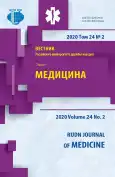Use of modulation interference microscopy in applied immunology
- Autores: Gizinger O.A.1, Levkova E.A.1, Savin S.Z.2
-
Afiliações:
- Peoples’ Friendship University
- Pacific National University
- Edição: Volume 24, Nº 2 (2020)
- Páginas: 168-175
- Seção: IMMUNOLOGY
- URL: https://journal-vniispk.ru/2313-0245/article/view/319593
- DOI: https://doi.org/10.22363/2313-0245-2020-24-2-168-175
- ID: 319593
Citar
Texto integral
Resumo
Objective: to determine the osmotic resistance of red blood cells using modulation interference microscopy technologies in the light microscopy mode of biological objects to identify the dynamics and determine the possibilities for continuing apitherapy in patients with autoimmune diseases. Methods. Methodological approaches to the use of modulation interference microscopy and computed tomography for the tasks of diagnostic medicine and applied immunology are described. The technology of vital computer dynamic phase metering, special methods for sample preparation of cytoobjects, as well as a computer-aided automated analysis of cytological images were used; recognition algorithms, measurement and identification of micro-objects; methods of statistical data processing. Results. Using the domestic innovative laser microscope MIM340, the osmotic resistance of erythrocytes was estimated using the method of modulation interference microscopy to identify the dynamics and determine the possibilities for continuing apitherapy in patients with rheumatoid arthritis and multiple sclerosis. Using computer methods of cytodiagnostics, new aspects of the functional morphology of living cells were revealed, clinical and morphological parallels were established. It was possible to evaluate the diagnostic and prognostic value of vital cell morphometry in various pathological processes and assess the effectiveness of therapeutic measures. A data bank of graphic images of red blood cells and blood lymphocytes of patients with diseases of the immune system has been created. Findings. The study of the structural features and functional usefulness of circulating blood cells is of great importance in addressing the pathogenesis, diagnosis, assessment of the severity of various pathological conditions and the effectiveness of the therapy. We believe that the study of living cytoobjects using the new method of coherent phase microscopy will provide the most objective data and increase the information content of the analysis, which is undoubtedly an urgent and promising task. The immediate plans include the refinement of mathematical, algorithmic, and software to support decision-making in computer-aided analysis of images of the epidermis and the surface of the dermis in neoplastic processes - malignant skin diseases. It is also necessary to create algorithmic and software tools for computerizing studies of cell models for quantitative and qualitative assessment of the selective accumulation of xenobiotics by laser microscopy.
Sobre autores
O. Gizinger
Peoples’ Friendship University
Autor responsável pela correspondência
Email: elenaalevkova@gmail.com
Moscow, Russia
E. Levkova
Peoples’ Friendship University
Email: elenaalevkova@gmail.com
Moscow, Russia
S. Savin
Pacific National University
Email: elenaalevkova@gmail.com
Khabarovsk, Russia
Bibliografia
- Brazhe A.R., Brazhe N.A., Ignatyev P.S. Phase-modulation laser interference microscopy: an advance in cell imaging and dynamics study. J. Biomed. Opt. 2007; 3(13):034004.
- Brehm-Stecher B., Johnson E. Single-cell microbiology: Tools, technologies, and applications. Microbiology and Molecular Biology Review. 2004;68: 538–59.
- Carl D., Kemper B., Wernicke G.B. Parameter-optimized digital holographic microscope for high-resolution living-cell analysis. Appl. 0pt. 2004;43: 6536–44.
- Deryugina A.V., Ignatiev P.S., Ivashchenko M.N. Erythrocytes and interference microscopy. Nizhny Novgorod: Lobachevsky national research Nizhny Novgorod state University.2019, 87 p.
- Levin G.G., Bulygin F.V., Vishnyakov G.N. Coherent oscillations of the state of protein molecules in living cells.Cytology. 2005; 47(4):348–56.
- Lazebnik M., Marks D., Potgier K. Functional optical coherence tomography for detecting neural activity through scattering changes. Opt. Lett. 2003;28(14):1218–20.
- Vishnyakov G.N., Levin G.G, Minaev V.L. Tomographic interference microscopy of living cells. Microscopy and Analysis. 2004; 87:19–21.
- Laboratory AMPHORA. Official site. [Electronic resource]. – 2019. – access Mode: http://www.amphoralabs.ru/projects/laser_ interference_microscopy.
- Deryugina A.V., Ivashchenko M.N., Samodelkin A.G. Lowlevel lazer therapy as a modifier of erythrocytes morphokinetic parameters in hyperadrenalinemia Lasers in Medical Science. 2019;8:1603–12.
- Huang Y., Karashima T., Yamamoto M. Raman spectroscopic signature of life in a living yeast cell. J. Raman Spectrosc. 2004;35:525–26.
- LaPorta A., Kleinfeld D. Interferometric Detection of Action Potentials. Spring Harbor Laboratory Press at SERIALS/ BIOMED LIB0175B, 2013. 6 p. Published by http://cshprotocols.cshlp.org/
- Naito Y., Tohe A., Hamaguchi H. In vivo time-resolved Raman imaging of a spontaneous death process of a single budding yeast cell. J. Raman Spectrosc. 2005;36: 837–39.
- Rappaz В., Marquet P., Cuche E. Measurement of the integral refractive index and dynamic cell morphometry of living cell with digital holographic microscopy. Optics Express. 2005;3(23):9361– 73.
- Deryugina A.V., Ivashchenko M.N., Ignatiev P.S. Changes in the phase portrait and electrophoretic mobility of red blood cells in various types of diseases. Modern technologies in medicine. 2019. Vol. 11. No. 2. Pp. 63–68.
- Kononenko B. JI. Flicker of red blood cells. 1. Review of the theory and methods of registration. Biological membranes. 2009; 26 (5): 352–69.
- Ignatiev P.S., Tychinsky V.P., Vyshenskaya T.V. ТInvestigation of lymphocyte activation by coherent phase microscopy.Almanac of clinical medicine. 2008;17(2):65–7.
- Loparev A.B., Ignatiev P.S., Indukaev K.B. high-Speed modulation interference microscope for biomedical research. Measuring technology. 2009;11:60–4.
Arquivos suplementares









